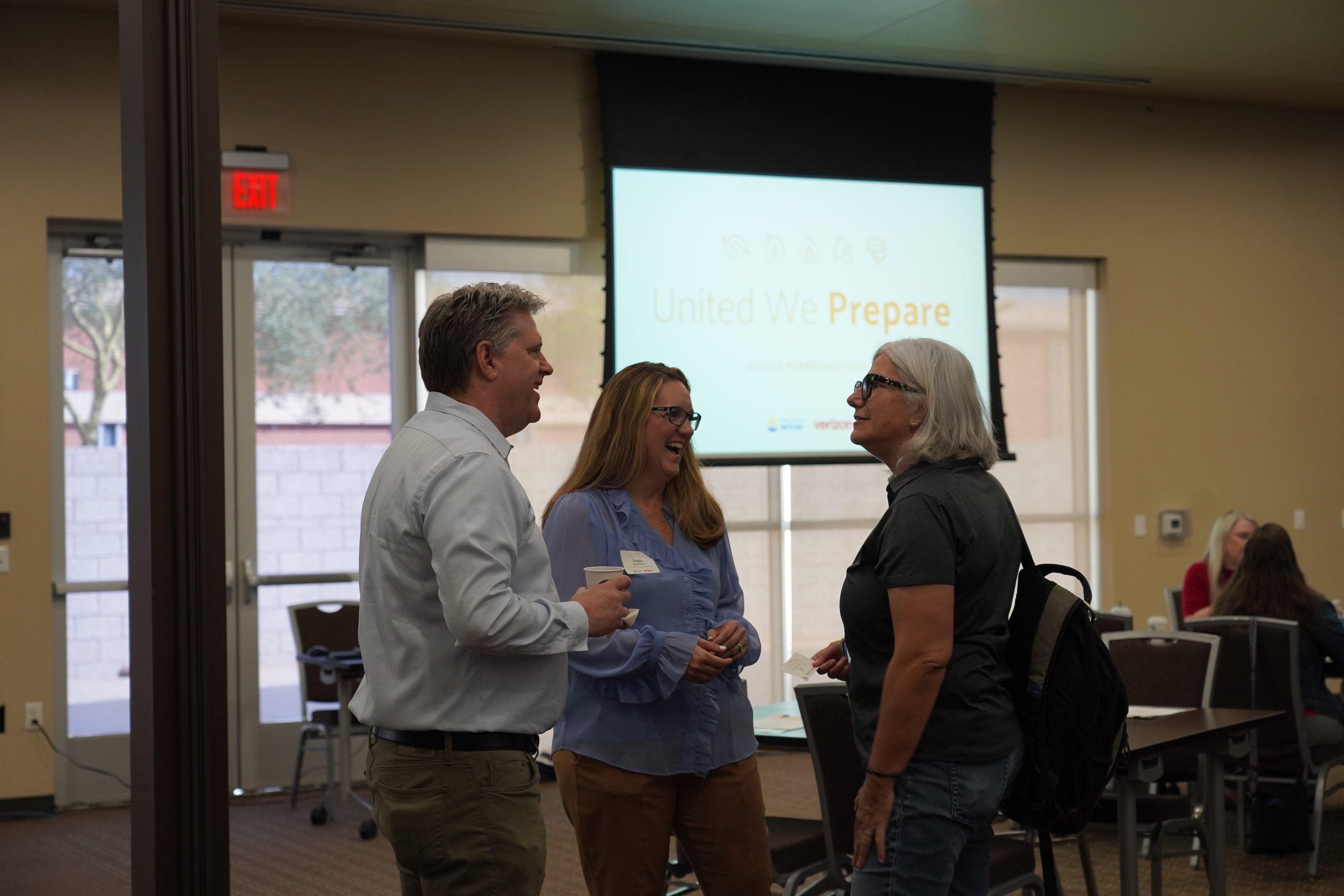Valley of the Sun United Way hosted the first ever United We Prepare: Disaster Preparedness Forum, in collaboration with Verizon, as part of United We Prepare –a nationwide effort made up of 14 United Ways, including Valley of the Sun United Way, to provide trusted and localized educational tools and resources to strengthen community resilience and create tangible impact before, during, and after emergencies.
“We are so thankful for our partnership with Verizon to help us build the resilience in our community,” said Emma Garcia, Chief Community Development & Engagement Officer at Valley of the Sun United Way. “This investment helps us to ensure that we are all proactively thinking about best practices when it comes to facing any disaster.”
Verizon has positioned themselves at the forefront of disaster preparedness, spearheading United We Prepare, and launching several new disaster resilience programs, including crisis response fleet trailers, portable cellular routers and connectivity mobile apps, and Virtual Emergency Operation Centers.
“Disaster preparedness is incredibly important for Verizon,” said Matthew Clark, Senior Government Affairs Manager at Verizon. “Our local partnership with Valley of the Sun United Way is longstanding. It’s events like today, where we have members of the community gather for thoughtful preparation, that leads to saving lives when disaster does strike.”
The forum, held at The Salvation Army, invited local nonprofit organizations and community leaders together to strengthen disaster readiness across Maricopa County. Attendees were able to learn and hear directly from several experts in the field, including representatives from Emergency Services at Arizona State University, Arizona Voluntary Organizations Active in Disaster, Emergency Services at the City of Chandler, the Phoenix Fire Department, Red Cross and Verizon Frontline.
Many insightful conversations were had amongst attendees and speakers, as well as essential lessons were taught, including a basic first aid demonstration and business continuity planning for Non-Governmental Organizations. The forum highlighted just how critical it is for nonprofits to think ahead and strengthen their preparedness strategies. Here are three key takeaways from the forum that every organization can put into practice.
Takeaway 1: Identify and Strengthen Your Support Network
One of the biggest tools to rely on in is preparedness in the form of people and connection. A support network is essential, both within your organization, and in a broader sense with those around you. Do preliminary outreach and research pertaining to who can step in to strengthen and stabilize your organization, such as cross-trained service providers or local businesses who can deploy essentials such as food or water.
“We aren’t experts in the face of every disaster, but we have partners who are,” said Sam Kroack, Senior Client Partner for Verizon Frontline. “We understand our roles and responsibilities, we utilize these relationships and leverage them, so we can better support our community.”
After you identify the key individuals around you, foster those connections by creating a joint plan together of how you can leverage each other’s resources and expertise. Finally, be sure to have this network easily accessible at any given time – by doing periodic check-ins and setting up tools such as “emergency contacts”.
Building a support network may take time, but it pays off when every minute counts.
Takeaway 2: Connect with Key Public Safety Leaders and Leverage Technology
Another key theme was the importance of building proactive relationships with public safety officials and emergency management teams. Having these conversations in advance ensures your organization knows who to contact and what resources are available in your area.
“Mutual aid agreements are extremely important in the face of a disaster,” said Erika Huston, Emergency Manager for the City of Chandler. “Many times, disaster funds do not go to those who are most vulnerable. How do we make communities whole? It starts with the conversations between community members and community leaders. It starts with learning from the experts and then equipping others with the tools they need.”
Technology plays a vital role in this as well. Many emergency services, and subsequently their leaders, are accessible via disaster preparedness apps. For example, Red Cross has a free disaster preparedness app that provides expert tips and tools. Maricopa County has released a “Ready Maricopa Community Preparedness” mobile app that provides critical emergency notifications and locations of emergency shelters across the region.
By equipping your organization with streamlined access to community leaders and valuable tools, you ensure the individuals you serve are better prepared as well.
Takeaway 3: Assess Your Needs and Make a Plan
Every nonprofit is unique – some are large, some are small, and many have their own niche ways of servicing the community. Taking this into account, every nonprofit should have their own unique preparedness strategy – starting with assessing your basic needs. What are the essentials needed for your organization to continue operations in times of crisis? What practices can you put into place ahead of time to ensure continuity of services?
“When it comes to disaster, essential functions and records should be the upmost priority, especially when putting together a contingency plan.” said Cayla Grace Sullivan, Emergency Management Coordinator at Arizona State University.
“The best way to assess your priorities is to look at your day-to-day tasks and evaluate which ones provide critical services that people rely on. If a disaster were to happen, what are the first things you would do in a 24-hour period? Identify those functions and develop backup plans to make sure they can run, even in a variety of situations.” Cayla added.
In most scenarios, to continue operations, it starts with the basics. One of the easiest ways to create smoothness and efficiency is to equip your organization and staff with emergency go kits.
Ready.gov’s Build a Kit list includes (but not limited to):
-Essential identification, records, and documents (birth or marriage certificates, passports, etc.)
-Enough water for three days, which is one gallon per person, per day
-Emergency tools such as a battery-powered radio and power banks
-First-aid kits, medications, and medical devices
Another pro tip is to have extra emergency kits, ready to go for the individuals you may serve. Every organization may be different, but what always stays the same is the vital responsibility to serve our communities.
Considering these three takeaways, attendees left the forum feeling empowered to face any disaster head on – knowing that they could access a plethora of resources and could identify new individuals to rely on for their support networks.
“I love that we touched on the fact we shouldn’t always wait for a ‘go-signal’,” said Boneca Brauer, CEO and Chief Warrior Companion of local nonprofit, Village 360. “Sometimes, we just need to be ready to go. I feel like my organization is now ready to go, no matter what.”
What we learned at the forum is clear: preparedness is about partnership, people, and planning. With the support of Verizon, this United We Prepare event was just the first of many. By providing nonprofits with the confidence and resources to take real steps forward, together we will create a more united Valley – one that is ready to move in the face of any disaster.
At Valley of the Sun United Way, our commitment is to continue building a safety net so that the Valley community is stronger and more resilient for centuries to come.
To ensure your organization and community are equipped, and for additional resources, visit vsuw.org/disasterprep.

